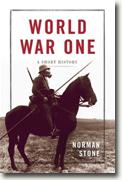World War One
Norman Stone
book reviews:
· general fiction
· chick lit/romance
· sci-fi/fantasy
· graphic novels
· nonfiction
· audio books
· author interviews
· children's books @
curledupkids.com
· DVD reviews @
curledupdvd.com
newsletter
win books
buy online
links
home
for authors
& publishers
for reviewers

 |
World War One: A Short History Norman Stone Basic Books Hardcover 240 pages April 2009 |
|
There is no gainsaying the fact that the First World War was a watershed event in the modern history of the world. The number of combatants who eventually died reached 14 million, the number who were wounded reached 20 million, and four empires were, in effect, destroyed. What circumstances led to this horrible war? Why were the warring parties unable to agree on peace terms before 1918? Why was the United States drawn into this war? In the aftermath of this war, what was the prognosis for the future? These and other related questions comprise the subject matter of this thought-provoking little book.
No war, says the author, began with as “fundamental [a] misunderstanding of its nature” (p. 36) as did the First World War. Leaders all over Europe assumed that the war would be short. This did not happen. In addition, throughout Western Europe, the fighting unfolded in such a manner that by the end of 1914, a pattern began to emerge. Specifically, “in the west [the result was] a stalemate, and in the east a more or less constant Austro-Hungarian crisis” (p. 54) arose. Chapter 4, without a doubt the most absorbing chapter in this book, addresses the many riveting events of 1916. The discussion begins with the famous battle at Verdun. Stone explains that in late 1915, Germany knew that even though time was not on its side, it had a great advantage as far as the output of ammunition was concerned. Therefore, a significant benefit would be obtained if this advantage were used to hammer the French “in a place where the French would have no alternative but to stand and be battered” (p. 93). This place was Verdun. However, despite a ferocious German onslaught, German objectives were ultimately not fulfilled because the French did not collapse. Even so, the psychological impact of Verdun on the French was tremendous. This battle “broke the French army...to such a degree that the country never really recovered...” (p. 96). Moving forward in time, the author sagaciously notes that when France did fall in 1940, it was “partly because her people did not want to go through Verdun again” (p. 97). By the time 1918 rolled along, the Allied powers and Germany were in dire straits, but for different reasons. In this despondent setting, the German foreign secretary Kuhlmann made the first and only serious peace overture to the Allies. As fate would have it, Kuhlmann’s peace overtures were spurned by the British, and Kuhlmann himself was dismissed from his post by the seemingly omnipotent General Erich Ludendorff. In October 1918, when the Americans broke through the so-called “Kriemhild line” and threatened the great German railway base at Metz, it was “obvious enough that Germany would be defeated” (p. 175). The author concludes the proceedings with two salient points. First, he notes that the real disaster of the First World War “was that Germans did not think that they had been defeated. They had...been ‘stabbed in the back’: Jews, the Left, soft-brained academics had prevented them from winning the war and setting up a Europe that had more sense, on the ground, than anything dreamed up by the naive Americans” (p. 189). Second, he points out that the harsh terms of the Versailles treaty left the way “open for a Second World War even more terrible than the First” (p. 190). In conclusion, let me note the following. This book does have a small number of quixotic sentences, and the explanations of events and their causes are, on occasion, somewhat terse. Even so, it is, in general, well-written; it has apposite doses of both sarcasm and humor, and it covers the major events and the personalities of the First World War with admirable aplomb. Therefore, this book is recommended to all readers who do not wish to peruse an encyclopedic tome on the First World War but would instead like a lucid account of the of the primary battles and the appalling consequences of this dreadful war. Originally published on Curled Up With A Good Book at www.curledup.com. © Amitrajeet A. Batabyal, 2009 |
|
|
|
 Click here to learn more about this month's sponsor! |
|
| fiction · sf/f · comic books · nonfiction · audio newsletter · free book contest · buy books online review index · links · · authors & publishers reviewers |
|
| site by ELBO Computing Resources, Inc. | |
 The seven chapters of
The seven chapters of